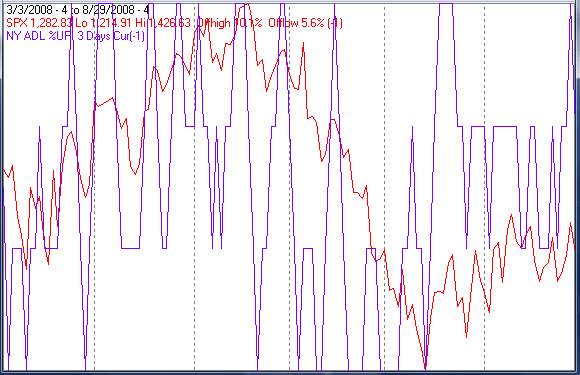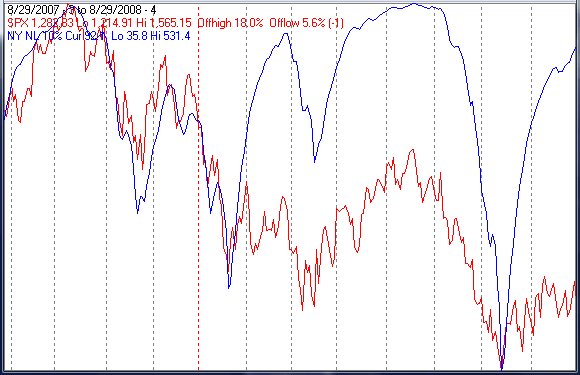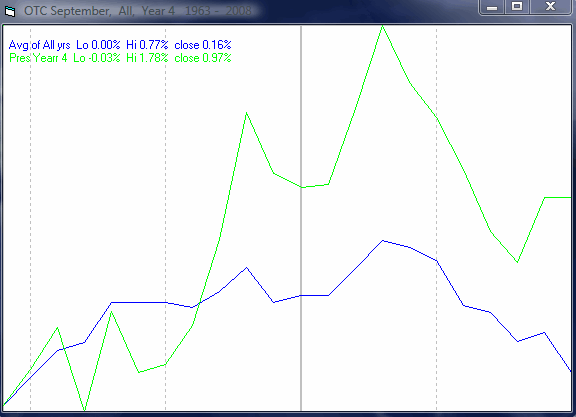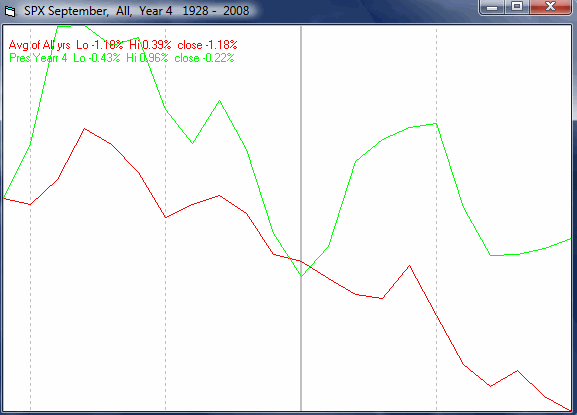Stock Markets Heading for a Retest of July Lows
Stock-Markets / US Stock Markets Aug 30, 2008 - 09:03 PM GMTBy: Mike_Burk
 The good news is: Since the July lows the secondaries have been stronger than the blue chips.
The good news is: Since the July lows the secondaries have been stronger than the blue chips.
Short Term The market is playing a disappearing act. Volume and new highs are at their lowest levels in years. Identifying strength or weakness under these conditions is challenging.
The chart below covers the past 6 months showing the S&P 500 (SPX) in red and an indicator showing the percentage of the last 3 days the NYSE ADL has been up in blue. The NYSE ADL is a running total of NYSE declining issues subtracted from advancing issues. Dashed vertical lines have been drawn on the 1st trading day of each month.
You do not have to look very carefully at this one. Just look for the empty areas. When the market is going up the indicator often hits the top of the chart and rarely touches the bottom. The opposite is true when the market is falling. The last time the indicator hit the bottom of the chart was at the July low while the last time it hit the top of the chart was last Thursday.

This indicator has not been overwhelmingly positive, but the bias has been to the upside.
Intermediate Term
On July 15 there were 1304 new lows on the NYSE, a record. After every record or, with only one exception, after every time there were even half as many new lows as we saw on July 15 there has been a retest of the low by the blue chip indices. A retest of the July 15 low in the next several weeks is likely.
The chart below covers the past year showing the S&P 500 (SPX) in red and a 10% trend (19 day EMA) of NYSE new lows (NY NL) in blue. NY NL has been plotted on an inverted Y axis so increasing new lows move the indicator upward (up is good).
If a retest occurs in the next month or so NY NL will be much higher than it was at the July 15 lows.

The next chart shows the exception mentioned above.
On August 31, 1998 there were 1183 new lows on the NYSE, a record that held until last July. On October 10, 1998 there was a retest of the August 31 low on the retest there were 930 new lows and NY NL was considerably higher at the time. After the August 31 low the Fed opened the spigots and money supply was growing at a 24% annualized rate at the time of the October retest.

Seasonality
Next week includes the first 4 trading days of September during the 4th year of the Presidential Cycle.
The tables show the daily return on a percentage basis for the first 4 trading days of September during the 4th year of the Presidential Cycle. OTC data covers the period from 1963 - 2007 and SPX data from 1928 - 2007. There are summaries for both the 4th year of the Presidential Cycle and all years combined.
By all measures the market has been up about 60% of the time during the coming week with modest gains.
First 4 days of September.
The number following the year represents its position in the presidential cycle.
The number following the daily return represents the day of the week;
1 = Monday, 2 = Tuesday etc.
| OTC Presidential Year 4 | |||||
| Day1 | Day2 | Day3 | Day4 | Totals | |
| 1964-4 | -0.12% 2 | 0.07% 3 | 0.39% 4 | 0.58% 5 | 0.92% |
| 1968-4 | 0.34% 2 | 0.24% 3 | -0.06% 4 | 0.55% 5 | 1.07% |
| 1972-4 | 0.58% 5 | -0.28% 2 | -0.54% 3 | -0.32% 4 | -0.57% |
| 1976-4 | 0.99% 3 | 0.10% 4 | 0.37% 5 | 0.21% 2 | 1.68% |
| 1980-4 | 0.45% 2 | 1.20% 3 | 0.28% 4 | 0.30% 5 | 2.24% |
| 1984-4 | -1.28% 2 | -0.31% 3 | 0.64% 4 | -0.21% 5 | -1.16% |
| Avg | 0.22% | 0.19% | 0.14% | 0.11% | 0.65% |
| 1988-4 | -0.95% 4 | 0.95% 5 | 0.22% 2 | 0.17% 3 | 0.38% |
| 1992-4 | 0.44% 2 | 1.00% 3 | 0.64% 4 | -0.25% 5 | 1.82% |
| 1996-4 | 0.07% 2 | 0.13% 3 | -1.58% 4 | 1.22% 5 | -0.16% |
| 2000-4 | 0.66% 5 | -2.15% 2 | -3.14% 3 | 2.12% 4 | -2.50% |
| 2004-4 | 0.67% 3 | 1.24% 4 | -1.55% 5 | 0.76% 2 | 1.13% |
| Avg | 0.18% | 0.23% | -1.08% | 0.80% | 0.13% |
| OTC summary for Presidential Year 4 1964 - 2004 | |||||
| Averages | 0.17% | 0.20% | -0.39% | 0.47% | 0.44% |
| % Winners | 73% | 73% | 55% | 73% | 64% |
| MDD 9/6/2000 5.22% -- 9/5/1984 1.58% -- 9/5/1996 1.58% | |||||
| OTC summary for all years 1963 - 2007 | |||||
| Averages | 0.09% | 0.11% | -0.03% | 0.16% | 0.32% |
| % Winners | 61% | 67% | 60% | 60% | 56% |
| MDD 9/7/2001 6.52% -- 9/4/1974 5.48% -- 9/6/2000 5.22% | |||||
| SPX Presidential Year 4 | |||||
| Day1 | Day2 | Day3 | Day4 | Totals | |
| 1928-4 | 0.00% 6 | 0.48% 2 | 0.48% 3 | -0.62% 4 | 0.34% |
| 1932-4 | 0.95% 4 | 4.37% 5 | 2.49% 6 | -1.66% 2 | 6.15% |
| 1936-4 | -0.25% 2 | 0.38% 3 | -0.37% 4 | 0.44% 5 | 0.19% |
| 1940-4 | 0.00% 2 | 2.08% 3 | 1.39% 4 | -0.73% 5 | 2.74% |
| 1944-4 | 0.31% 5 | -0.62% 2 | -2.43% 3 | -0.32% 4 | -3.06% |
| Avg | 0.20% | 1.34% | 0.31% | -0.58% | 1.27% |
| 1948-4 | 1.19% 3 | 0.50% 4 | 0.18% 5 | 0.49% 2 | 2.36% |
| 1952-4 | 0.48% 2 | 0.40% 3 | -0.04% 4 | -0.12% 5 | 0.72% |
| 1956-4 | 0.80% 2 | 0.27% 3 | 0.17% 4 | -0.60% 5 | 0.63% |
| 1960-4 | 0.23% 4 | -0.16% 5 | -0.89% 2 | -1.24% 3 | -2.06% |
| 1964-4 | 0.43% 2 | 0.16% 3 | 0.30% 4 | 0.24% 5 | 1.13% |
| Avg | 0.62% | 0.23% | -0.06% | -0.25% | 0.56% |
| 1968-4 | 0.47% 2 | 0.70% 3 | 0.72% 4 | 0.46% 5 | 2.35% |
| 1972-4 | 0.38% 5 | -0.25% 2 | -0.61% 3 | -0.24% 4 | -0.72% |
| 1976-4 | 1.12% 3 | -0.13% 4 | 0.37% 5 | 0.70% 2 | 2.05% |
| 1980-4 | 1.10% 2 | 1.93% 3 | -0.56% 4 | -0.43% 5 | 2.05% |
| 1984-4 | -1.08% 2 | -0.36% 3 | 0.83% 4 | -0.77% 5 | -1.38% |
| Avg | 0.40% | 0.38% | 0.15% | -0.06% | 0.87% |
| 1988-4 | -1.21% 4 | 2.37% 5 | 0.42% 2 | 0.11% 3 | 1.69% |
| 1992-4 | 0.49% 2 | 0.46% 3 | 0.00% 4 | -0.22% 5 | 0.74% |
| 1996-4 | 0.42% 2 | 0.13% 3 | -0.94% 4 | 0.96% 5 | 0.58% |
| 2000-4 | 0.20% 5 | -0.90% 2 | -0.98% 3 | 0.69% 4 | -0.99% |
| 2004-4 | 0.15% 3 | 1.12% 4 | -0.42% 5 | 0.69% 2 | 1.54% |
| Avg | 0.01% | 0.64% | -0.38% | 0.45% | 0.71% |
| SPX summary for Presidential Year 4 1928 - 2004 | |||||
| Averages | 0.31% | 0.65% | 0.01% | -0.11% | 0.85% |
| % Winners | 75% | 70% | 50% | 45% | 75% |
| MDD 9/7/1944 3.34% -- 9/7/1960 2.28% -- 9/6/2000 1.88% | |||||
| SPX summary for all years 1928 - 2007 | |||||
| Averages | -0.04% | 0.14% | 0.25% | -0.11% | 0.24% |
| % Winners | 68% | 56% | 57% | 43% | 58% |
| MDD 9/4/1946 7.15% -- 9/4/1974 4.80% -- 9/7/1933 4.72% | |||||
September
Since 1963 the OTC has been up 62% of the time in September, but it has had an average loss of 0.2% for the month. The average loss was helped significantly by losses of 13.3% in 2000 and 15.4% in 2001. During the 5 year period from 1999 to 2003 the OTC was down every September. During the 4th year of the Presidential Cycle (which includes 2000) the OTC has been up 73% of the time with an average gain of 1.1%.
The average month has 21 trading days. The chart below has been calculated by averaging the daily percentage change of the OTC for each of the 1st 11 trading days and each of the last 10. In months when there were more than 21 trading days some of the days in the middle were not calculated. In months when there were less than 21 trading days some of the days in the middle were counted twice. Dashed vertical lines have been drawn after the 1st trading day and at 5 trading day intervals after that. The line is solid on the 11th trading day, the dividing point.
The blue line shows the average of all years since 1963 while the green line shows the average during the 4th year of the Presidential Cycle.

Since 1928 the SPX has been up 45% of the time in September with an average loss of 1.1% for the month making it the worst month of the year. The worst September of all was in 1930 when the SPX lost 30.2%, the best September of all was 1939 when it gained 15.2%. During the 4th year of the Presidential Cycle the SPX has been up 60% of the time with an average loss of 0.3% putting it ahead of May (-1.3%), April (-0.9%) and February (-0.5%).
The chart below has been calculated like the one above. The red line shows the average September over all years since 1928 while the green line shows the average over the 4th year of the Presidential Cycle.

Conclusion
A retest of the July lows for the blue chips in the next month or so is likely. If and when it occurs it will be unconfirmed by the secondaries or new lows.
I expect the major indices to be higher on Friday September 5 than they were on Friday August 29.
Last week the blue chips were down a little while the secondaries were up a little so I am calling last weeks positive forecast a tie.
Thank you,
By Mike Burk
To subscribe to this report : http://alphaim.net/signup.html
Gordon Harms produces a Power Point for our local timing group. You can get a copy of that at: http://www.stockmarket-ta.com/ .
Disclaimer: Mike Burk is an employee and principal of Alpha Investment Management (Alpha) a registered investment advisor. Charts and figures presented herein are believed to be reliable but we cannot attest to their accuracy. Recent (last 10-15 yrs.) data has been supplied by CSI (csidata.com), FastTrack (fasttrack.net), Quotes Plus (qp2.com) and the Wall Street Journal (wsj.com). Historical data is from Barron's and ISI price books. The views expressed are provided for information purposes only and should not be construed in any way as investment advice. Furthermore, the opinions expressed may change without notice.
Mike Burk Archive |
© 2005-2022 http://www.MarketOracle.co.uk - The Market Oracle is a FREE Daily Financial Markets Analysis & Forecasting online publication.




